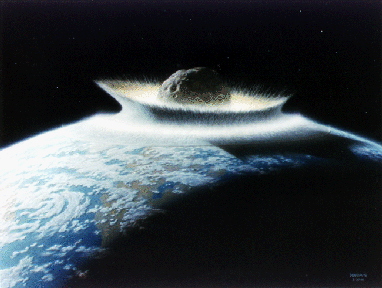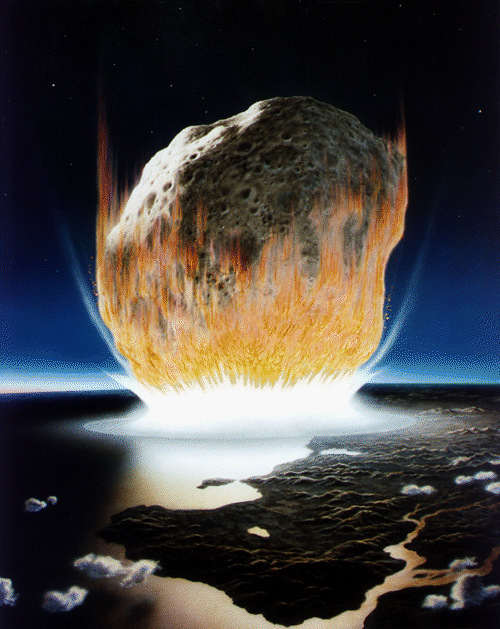 On June 30, 1908, a giant fireball raced across the night sky. Then it exploded with the force of 1,000 Hiroshima bombs killing herds of reindeer and scorching hundreds of miles of trees. It happened in a remote place in Siberia called Tunguska. The night sky had a strange orange glow as far away as Western Europe. The only proof that something happened was a quiver on a seismograph 1,000 miles away in the city of Irkutusk.
On June 30, 1908, a giant fireball raced across the night sky. Then it exploded with the force of 1,000 Hiroshima bombs killing herds of reindeer and scorching hundreds of miles of trees. It happened in a remote place in Siberia called Tunguska. The night sky had a strange orange glow as far away as Western Europe. The only proof that something happened was a quiver on a seismograph 1,000 miles away in the city of Irkutusk.
Scientists did not come to the sight for another 19 years. When they finally did come, what they saw was a place of utter devastation. They searched for a crater, a piece of and asteroid or meteorite but found nothing. They were able to find eyewitnesses in neighboring villages though. They recalled that there had been a fireball streaking through the sky, a horrifying noise, and an enormous blast.
From then on there have been many theories as to what happened that early June morning. The theories ranged from meteor impact to an exploding spaceship. Using computer simulations, scientists know it is a meteorite from an asteroid that fragmented in the atmosphere.
 The first person to visit Tunguska was Leonid Kulik. When he first saw the vast area of charred trees, he thought that a huge fire had started all at once. Kulik and his team photographed the area and searched for meteorite fragments but found nothing. Over the next 14 years, he lead four more expeditions to Tunguska, but turned up empty-handed. Kulik died in 1942 as a prisoner of war.
The first person to visit Tunguska was Leonid Kulik. When he first saw the vast area of charred trees, he thought that a huge fire had started all at once. Kulik and his team photographed the area and searched for meteorite fragments but found nothing. Over the next 14 years, he lead four more expeditions to Tunguska, but turned up empty-handed. Kulik died in 1942 as a prisoner of war.
In 1946, a Soviet engineer and army colonel wrote a short story explaining that the destruction at Tunguska could only have been from a nuclear bomb, and that since humans did not have that capability in 1908, it must have been an exploding spaceship. The book became popular in the Soviet Union and a group of scientists, Victor Zhuravlyov and Gennady Plekhanov, decided to find out if it were true. There would still be measurable levels of radiation. They searched for two years but found nothing.
Since then, Russian scientists have gone to Tunguska ever summer. One of the most useful things they did was map the entire 850 square mile region of tree fall. This task took them 35 years to do. This map has allowed scientist to calculate that the blast must have been four miles above the Earth with a force of 10 to 20 megatons of TNT.
 In 1989 an Italian named Menotti Galli had a theory that tiny particles of the object would be stuck in the resin of the trees. He went to Tunguska in 1991 and painstakingly searched for spruces that had survived the 1908 blast. In all they found six samples in a 5-mile radius. They found that the particles in the trees had unusually high levels of elements. These elements were also smooth in texture and had a rounded shape. This meant that they had to be heated at a high temperature.
In 1989 an Italian named Menotti Galli had a theory that tiny particles of the object would be stuck in the resin of the trees. He went to Tunguska in 1991 and painstakingly searched for spruces that had survived the 1908 blast. In all they found six samples in a 5-mile radius. They found that the particles in the trees had unusually high levels of elements. These elements were also smooth in texture and had a rounded shape. This meant that they had to be heated at a high temperature.
A group of American scientists found that small meteorites would burn up while large meteorites hit the ground. However, medium objects between 10 and 300 feet wide explode in midair. They used a computer program to test their different theories. The found that a stony meteorite, 200 feet wide falling at a 45-degree angle would explode at just the right height. They also found that after the explosion, only fine gravel would fall into the swamps below.
